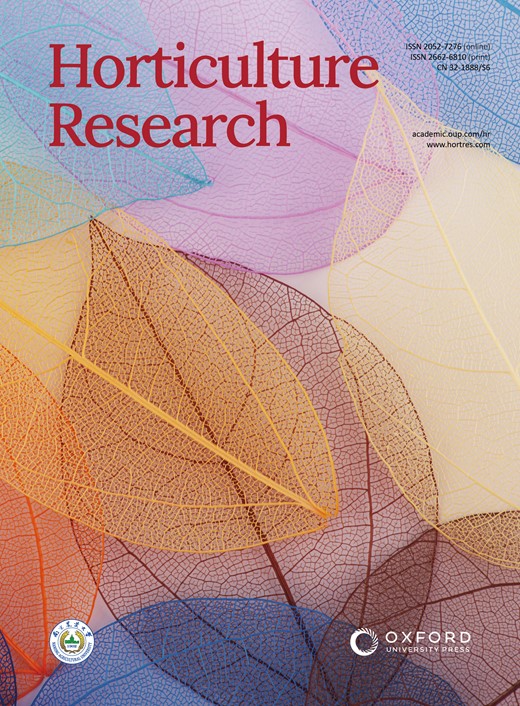BnaMS1/BnaMS2 的靶向突变与 RUBY 报告器相结合,实现了甘蓝型油菜杂交种子生产的高效双线系统
IF 8.7
1区 农林科学
Q1 Agricultural and Biological Sciences
引用次数: 0
摘要
隐性基因雄性不育(RGMS)方法在杂交种子生产中具有多种优势;然而,由于难以生产出大量纯合的雄性不育种子,该方法很少用于工业化杂交种子生产。在本研究中,我们提出了一种有效的方法,通过对甘蓝型油菜中的 BnaMS1 和 BnaMS2 以及 RUBY 报告基因进行定向突变,开发出一种双线策略来生产杂交种子。在这种方法中,通过 CRISPR/Cas9 介导的诱变和农杆菌介导的强化转化,成功地从不同的油菜育种精英品系中直接培育出雄性不育系。为了建立高效的转基因保持系,在油菜籽中测试并比较了三种携带与不同报告基因(DsRed、BnaA07.PAP2 和 RUBY)相连的功能性 BnaMS1 基因的 SPT 载体。结果表明,基于 PMR 的报告基因具有表型稳定、易于早期鉴定等优点,是快速高效筛选的理想工具。随后,在 Bnams1Bnams2 双突变体的背景下,成功培育出了具有 SPT 盒单个半杂合子拷贝的理想转基因保持系。该保持系与其雄性不育对应株杂交的后代表现出非转基因雄性不育和雄性不育保持系植株1:1的分离模式,并可通过幼苗颜色加以区分。这种雄性不育的生物技术方法为改善隐性基因雄性不育植株的繁殖和油菜杂交种子的培育提供了广阔的前景。此外,将这种技术应用于更多芸薹属作物也很简单。本文章由计算机程序翻译,如有差异,请以英文原文为准。
Targeted mutation of BnaMS1/BnaMS2 combined with the RUBY reporter enables an efficient two-line system for hybrid seed production in Brassica napus
The recessive genic male sterility (RGMS) method has several benefits in hybrid seed production; yet, it is seldom employed in industrial hybrid seed production owing to the difficulties of producing an ample number of pure male sterile seeds. In this study, we present an efficient methodology for developing a two-line strategy to produce hybrid seed through targeted mutation of BnaMS1 and BnaMS2 in conjunction with the RUBY reporter in Brassica napus. In this method, male sterile lines were successfully created directly from different elite rapeseed breeding lines through CRISPR/Cas9-mediated mutagenesis and enhanced Agrobacterium-mediated transformation. To establish an efficient transgenic maintainer, three SPT vectors carrying a functional BnaMS1 gene linked to different reporters (DsRed, BnaA07.PAP2, and RUBY) were tested and compared in rapeseed. The results indicated that the PMR-based reporter possesses advantages such as phenotypic stability and ease of identification at early stages, making it an ideal tool for rapid and efficient screening. Subsequently, ideal transgenic maintainer lines with a single hemizygous copy of the SPT cassette were successfully developed in the context of Bnams1Bnams2 double mutants. The progeny from crossing the maintainer line with its male-sterile counterpart exhibited a 1:1 segregation pattern of nontransgenic male-sterile and male-fertile maintainer plants, distinguishable by seedling color. This biotechnological approach to male sterility offers promising prospects for improving the propagation of recessive genic male-sterile plants and the development of hybrid seeds in rapeseed. Furthermore, it is simple to adapt this technique to more Brassica crops.
求助全文
通过发布文献求助,成功后即可免费获取论文全文。
去求助
来源期刊

Horticulture Research
Biochemistry, Genetics and Molecular Biology-Biochemistry
CiteScore
11.20
自引率
6.90%
发文量
367
审稿时长
20 weeks
期刊介绍:
Horticulture Research, an open access journal affiliated with Nanjing Agricultural University, has achieved the prestigious ranking of number one in the Horticulture category of the Journal Citation Reports ™ from Clarivate, 2022. As a leading publication in the field, the journal is dedicated to disseminating original research articles, comprehensive reviews, insightful perspectives, thought-provoking comments, and valuable correspondence articles and letters to the editor. Its scope encompasses all vital aspects of horticultural plants and disciplines, such as biotechnology, breeding, cellular and molecular biology, evolution, genetics, inter-species interactions, physiology, and the origination and domestication of crops.
 求助内容:
求助内容: 应助结果提醒方式:
应助结果提醒方式:


